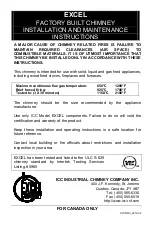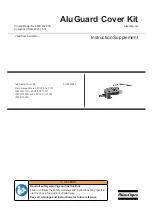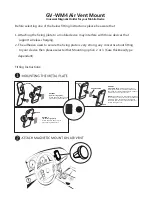
D-302894
7
9. TAKING CARE OF THE SMD-426 or SMD-427
9.1 Battery Replacement
The SMD-426 and SMD-427 were designed to be as maintenance-free
as possible. To keep the smoke detector in good working order, you
must test it weekly, as instructed in Para. 6.1 below.
Make it a rule to replace the detector’s battery (lithium) once
every 8 years even if there is no indication that the battery is
weak.
Also be sure to replace it immediately upon reception of a low
battery message via your control panel.
If you disregard this message, an audible reminder in the form of
once-per-minute "beep" will sound after a few days. The low-
battery "beep" should last at least 30 days before the battery dies
out completely.
NOTE:
For best performance, use only lithium batteries as
replacement batteries (see specifications). Carbon zinc batteries are
not acceptable.
Replace the battery as follows:
A.
Separate the detector from its bracket (see Figure 2).
B.
Replace battery (see Figure 9a or Figure 9b according to the
battery used).
9.2 Maintenance
It is necessary to maintain the detector frequently to ensure it working
properly. Follow these tips for taking care of your detector:
Use a vacuum cleaner to clean the air vents occasionally to keep
them free of dust. When a "Clean Warning" transmission is received,
the detector should be cleaned. When a trouble event is received, the
detector should be removed (see Table 1 for visual and audible
indications).
Perform detector functional test (see par. 3.7) weekly.
A clean (maintenance) signal is transmitted when the detector's
chamber sensitivity becomes degraded.
Note:
If false alarms keep occurring, check whether the detector's
location is adequate (see Para. 4.1 and 4.2). Relocate the unit if it is
not located properly. Clean as described above.
10. ADDITIONAL ADVICE
10.1 Routine Testing
The detector should be tested weekly and also whenever you suspect
that it does not go into alarm (for further details see par. 3.6). If the
detector fails, have it repaired or replaced immediately, to ensure that it
works properly.
Every 3 months the smoke detector must be checked by using smoke
detectors test sprayer.
WARNING: Never use an open flame of any kind to test your
detector. You may set fire to damage the detector as well as your
home. The built-in test switch accurately tests all detector
functions, as required by Underwriters' Laboratories. This is the
only correct way to test the unit.
NOTE:
If the alarm horn produces a loud continuous sound and the
red LED flashes when you are not testing the unit, this means the
detector has sensed smoke or combustion particles in the air. Verify
that the alarm is a result of a possible serious situation, which
requires your immediate attention.
•
The alarm could be caused by a false situation. Cooking smoke or
a dusty furnace, sometimes called "friendly fires" can cause the
alarm to sound. If this happens, open a window or fan the air away
to remove the smoke or dust. The alarm will turn off as soon as the
air is completely clear.
CAUTION:
Do not disconnect the battery from the detector. This
will remove your protection from fires.
•
If there is any question as to the cause of an alarm, it should
be assumed that the alarm is due to an actual fire and the
residence should be evacuated immediately.
If the alarm horn begins to beep once every 30 sec (for further details,
see par. 3.2), this signal means that the detector's battery is weak.
Install a new battery immediately. Keep fresh batteries on hand for
this purpose.
10.2 Tips to Enhance Your Protection
From Fires
Putting up smoke detectors is only one step in protecting your family
from fires. You must also reduce the chances of fires starting in your
home. You must also increase your chances of escaping safely if one
does start. To have a good fire safety program you must apply the
following tips to enhance your family's protection from fires:
A.
Install smoke detectors properly. Carefully follow all the
instructions in this manual. Keep your smoke detectors clean
and test them every week.
B.
Remember that detectors that do not work will not alert you.
Replace your smoke detectors immediately if they are not
working properly.
C.
Follow fire
safety
rules, and prevent hazardous situations:
•
Use smoking materials properly. Never smoke in bed.
•
Keep matches and cigarette lighters away from children.
•
Store flammable materials in proper containers. Never use them
near open flame or sparks.
•
Keep electrical appliances in good condition. Do not overload
electrical circuits.
•
Keep stoves, fireplaces, chimneys, and barbecue grills grease
free. Make sure they are properly installed and away from any
combustible materials.
•
Keep portable heaters and open flames such as candles away
from combustible materials.
•
Do not allow rubbish to accumulate.
•
Keep a supply of extra batteries on hand for your battery
powered smoke detectors.
D.
Develop a family escape plan and practice it with your entire
family. Be sure to include small children in your practice.
•
Draw a floor plan of your home, and find two ways to exit from
each room. There should be one way to get out of each
bedroom without opening the door.
•
Explain to children what the smoke detector alarm signal means.
Teach them that they must be prepared to leave the home by
themselves if necessary. Show them how to check to see if doors
are hot before opening them. Show them how to stay close to the
floor and crawl if necessary. Show them how to use the alternate
exit if the door is hot and should not be opened.
•
Decide on a meeting place which has a safe distance from your
house. Make sure that all your children understand that they
should go and wait for you there if there is a fire.
•
Hold fire drills at least every 6 months, making sure that everyone,
even small children, knows what to do to escape safely.
•
Know where to go to call the Fire Department outside your home.
•
Provide emergency equipment, such as fire extinguishers, and
teach your family to use this equipment properly.
10.3 More Tips on How to Face a Fire
at Home
If you have made an escape plan and practiced it with your family,
their chances of escaping safely are increased. Go over the following
rules with your children when you have fire drills. This will help
everyone remember the rules in a real emergency.
A.
Don't panic and stay calm. Your safe escape may depend on
thinking clearly and remembering what you have practiced.
B.
Get out of the house as quickly as possible. Follow a planned escape
route. Do not stop to collect anything or to get dressed.
C.
Feel the doors to see if they are hot. If they are not, open them
carefully. Do not open a door if it is hot. Use an alternate escape
route.
D.
Stay close to the floor. Smoke and hot gases rise.
E.
Cover your nose and mouth with a wet or damp cloth. Take short,
shallow breaths.
F.
Keep doors and windows closed. Open them only if you have to in
order to escape.
G.
Meet at your planned meeting place after leaving the house.
H.
Call the Fire Department as soon as possible from outside your
house. Give the address and your name.
I.
Never go back inside a burning building. Contact your local Fire
Department. They will give you more ideas about how to make your
home safer from fires and how to plan your family's escape.


























